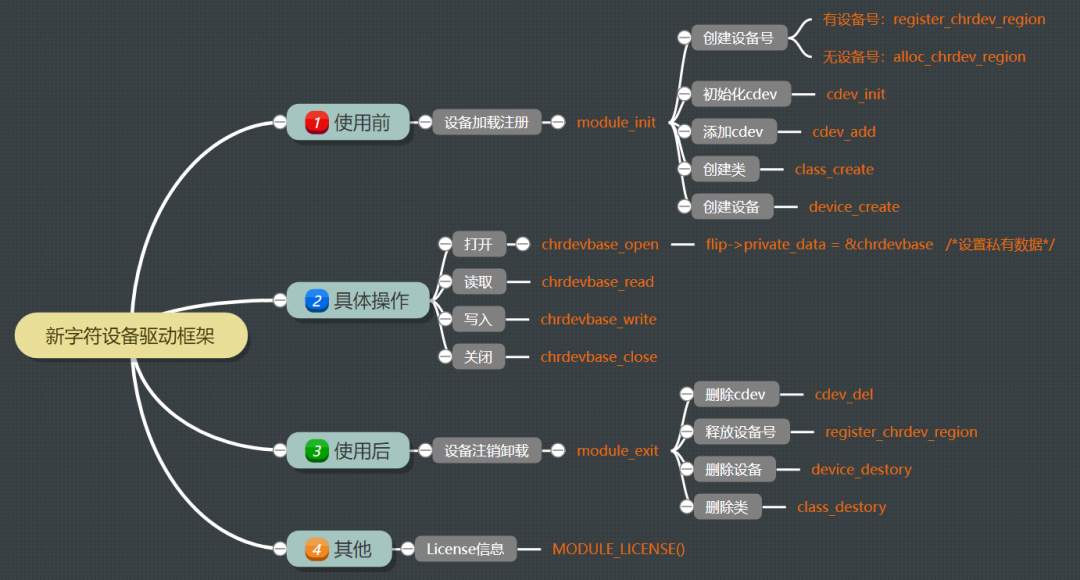Devicetree(設(shè)備樹)是用來描述系統(tǒng)硬件信息的樹模型,其旨在unify內(nèi)核。通過bootloader將devicetree的信息傳給kernel,然后kernel根據(jù)這些設(shè)備描述初始化相應(yīng)的板級驅(qū)動,達(dá)到一個(gè)內(nèi)核多個(gè)平臺共享的目的。
Overview
Devicetree主要為描述不可插拔(非動態(tài))設(shè)備的板級硬件信息而設(shè)計(jì)的。它由分層的描述設(shè)備信息的節(jié)點(diǎn)(node)組成樹結(jié)構(gòu)。每個(gè)node包含的內(nèi)容通過property/value對來表示。除root節(jié)點(diǎn)外,每個(gè)節(jié)點(diǎn)都有parent。如圖所示:

Node Names
除root節(jié)點(diǎn)名用'/'表示外,其余節(jié)點(diǎn)都由node-name@unit-address來命名,且同一層級必須是唯一的。
node-name
表示節(jié)點(diǎn)名,由1-31個(gè)字符組成。如非必須,推薦使用以下通用的node-name: cpu、memory、memory-controller、gpio、serial、watchdog、flash、compact-flash、rtc、interrupt-controller、dma-controller、ethernet、ethernet-phy、timer、mdio、spi、i2c、usb、can、keyboard、ide、disk、display、sound、atm、cache-controller、crypto、fdc、isa、mouse、nvram、parallel、pc-card、pci、pcie、sata、scsi、vme。
unit-address
表示這個(gè)節(jié)點(diǎn)所在的bus類型。它必須和節(jié)點(diǎn)中reg屬性的第一個(gè)地址一致。如果這個(gè)節(jié)點(diǎn)沒有reg屬性,則不需“@unit-address”。
Path Names
表示一個(gè)節(jié)點(diǎn)的完整路徑(full path)。型如:
/node-name-1/node-name-2/node-name-N
Properties
每個(gè)節(jié)點(diǎn)包含的主要內(nèi)容就是這個(gè)所描述的設(shè)備的屬性信息,由name和value組成:
Property Names
1-31個(gè)字符,可包含字母、數(shù)字、及‘,’,‘.’,‘_’,‘+’,‘?’,‘#’。
Property Values
ValueDescriptionempty屬性值為空,用來表示true-false信息u32/u6432/64位大端字節(jié)序的無符號整形,表示時(shí)需加<>string,stringlistnull-terminated字符串或其組成的列表
Standard Properties
compatible
Value type: Description: 表示兼容的設(shè)備類型,內(nèi)核據(jù)此選擇合適的驅(qū)動程序。由多個(gè)字符串組成,從左到由列出這個(gè)設(shè)備兼容的驅(qū)動(from most specific to most general)。 推薦的格式為:“制造商名,具體型號”。Example: compatible = "fsl,mpc8641-uart", "ns16550"; 內(nèi)核先搜索支持“fsl,mpc8641-uart”的驅(qū)動,如未找到,則搜索支持更通用的“ns16550”設(shè)備類型的驅(qū)動。
model
Value type: Description: 表明設(shè)備型號。 推薦的格式為:“制造商名,具體型號”。Example: model = "fsl,MPC8349EMITX";
phandle
Value type: Description: 用一個(gè)樹內(nèi)唯一的數(shù)字標(biāo)識所在的這個(gè)節(jié)點(diǎn),其他節(jié)點(diǎn)可以直接通過這個(gè)數(shù)字標(biāo)識來引用這個(gè)節(jié)點(diǎn)。Example: pic@10000000 { phandle = <1>; interrupt-controller; }; interrupt-parent = <1>;
status
Value type: Description: 表示設(shè)備的可用狀態(tài): "okay" -> 設(shè)備可用 "disabled" -> 目前不可用,但以后可能會可用 "fail" -> 不可用。出現(xiàn)嚴(yán)重問題,得修一下 "fail-sss" -> 不可用。出現(xiàn)嚴(yán)重問題,得修一下。sss指明錯(cuò)誤類型。
#address-cells and #size-cells
Value type: Description: 在擁有子節(jié)點(diǎn)的節(jié)點(diǎn)中使用,來描述它的字節(jié)點(diǎn)的地址分配問題。即分別表示子節(jié)點(diǎn)中使用多少個(gè)u32大小的cell來編碼reg屬性中的address域和size域。 這兩個(gè)屬性不會繼承,必須明確指出。如未指出,默認(rèn)#address-cells=2,#size-cells=1。Example: soc { #address-cells = <1>; #size-cells = <1>; serial { reg = <0x4600 0x100>; }; };
reg
Value type: encoded as an arbitraty number of (address, length) pairs.Description: 描述該設(shè)備在parent bus定義的地址空間中的地址資源分配。Example: reg = <0x3000 0x20 0xFE00 0x100>; a 32-byte block at offset 0x3000 and a 256-byte block at offset 0xFE00。
virtual-reg
Value type: Description: 表示映射到reg第一個(gè)物理地址對應(yīng)的effective address。使bootloader能夠提供給內(nèi)核它所建立的virtual-to-physical mappings。
ranges
Value type: or encoded as an arbitrary number of (child-bus-address,parent-bus-address, length) triplets.Description: 提供了子地址空間與父地址空間的映射關(guān)系,如果值為空則父子地址相等,無需轉(zhuǎn)換。Example: soc { compatible = "simple-bus"; #address-cells = <1>; #size-cells = <1>; ranges = <0x0 0xe0000000 0x00100000>; serial { compatible = "ns16550"; reg = <0x4600 0x100>; }; }; 將子節(jié)點(diǎn)serial的0x0地址映射到父節(jié)點(diǎn)soc的0xe0000000,映射長度為0x100000。此時(shí)reg的實(shí)際物理地址就為0xe0004600。
dma-ranges
Value type:
Interrupts
描述中斷的屬性有4個(gè):
interrupt-controller
一個(gè)空的屬性用來指示這個(gè)節(jié)點(diǎn)設(shè)備是接收中斷信號的控制器。
#interrupt-cells
這是上面所說中斷控制器中的一個(gè)屬性,用來描述需要用多少個(gè)cell來描述這個(gè)中斷控制器的interrupt specifier(類似#address-cells和#size-cells)。
interrupt-parent
常出現(xiàn)在根節(jié)點(diǎn)的一個(gè)屬性,它的屬性值是指向interrupt-controller的一個(gè)phandle。可從parent繼承。
interrupts
包含interrupt specifiers列表,每一個(gè)specifier表示一個(gè)中斷輸出信號。
Example
/ { interrupt-parent = <&intc>; intc: interrupt-controller@10140000 { compatible = "arm,pl190"; reg = <0x10140000 0x1000 >; interrupt-controller; #interrupt-cells = <2>; }; serial@101f0000 { interrupts = < 1 0 >; };};
Base Device Node Types
所有的設(shè)備樹都必須有一個(gè)root節(jié)點(diǎn),且root節(jié)點(diǎn)下必須包含一個(gè)cpus節(jié)點(diǎn)和至少一個(gè)memory節(jié)點(diǎn)。
root node
root節(jié)點(diǎn)須包含 #address-cells、#size-cells、model、compatible等屬性。
/cpus node
是cpu子節(jié)點(diǎn)的父節(jié)點(diǎn)容器。須包含 #address-cells、#size-cells屬性。
/cpus/cpu* node
是描述系統(tǒng)cpu的節(jié)點(diǎn)。
/memory node
描述系統(tǒng)物理內(nèi)存的layout。須包含reg節(jié)點(diǎn)。Example:假如一個(gè)64位系統(tǒng)有如下兩塊物理內(nèi)存:- RAM: starting address 0x0, length 0x80000000 (2GB)- RAM: starting address 0x100000000, length 0x100000000 (4GB)則我們可以有下面兩種描述方法(#address-cells = <2> and #size-cells =<2>):Example #1 memory@0 { reg = <0x000000000 0x00000000 0x00000000 0x80000000 0x000000001 0x00000000 0x00000001 0x00000000>; };Example #2 memory@0 { reg = <0x000000000 0x00000000 0x00000000 0x80000000>; }; memory@100000000 { reg = <0x000000001 0x00000000 0x00000001 0x00000000>; };
/chosen node
根節(jié)點(diǎn)下的一個(gè)子節(jié)點(diǎn),不是描述設(shè)備而是描述運(yùn)行時(shí)參數(shù)。常用來給內(nèi)核傳遞bootargs:chosen { bootargs = "root=/dev/nfs rw nfsroot=192.168.1.1 console=ttyS0,115200";};
/aliases node
由1-31個(gè)字母、數(shù)字或下劃線組成的設(shè)備節(jié)點(diǎn)full path的別名。它的值是節(jié)點(diǎn)的全路徑,因此最終會被編碼成字符串。aliases { serial0 = "/simple-bus@fe000000/serial@llc500";}
Device Bindings
更多具體設(shè)備具體類別的描述信息:內(nèi)核源代碼/Documentation/devicetree/bindings。
DTS是描述devicetree的源文本文件,它通過內(nèi)核中的DTC(Devicetree Compiler)編譯后生成相應(yīng)平臺可燒寫的二進(jìn)制DTB。
Devicetree Blob (DTB) Structure
DTB又稱Flattened Devicetree(FDT),在內(nèi)存中的結(jié)構(gòu)如下圖所示:

Header
大端字節(jié)序結(jié)構(gòu)體:
struct fdt_header { uint32_t magic; /* contain the value 0xd00dfeed (big-endian) */ uint32_t totalsize; /* the total size of the devicetree data structure */ uint32_t off_dt_struct; /* offset in bytes of the structure block */ uint32_t off_dt_strings; /* offset in bytes of the strings block */ uint32_t off_mem_rsvmap; /* offset in bytes of the memory reservation block */ uint32_t version; /* the version of the devicetree data structure */ uint32_t last_comp_version; /* the lowest version used is backwards compatible */ uint32_t boot_cpuid_phys; /* the physical ID of the system’s boot CPU */ uint32_t size_dt_strings; /* the length in bytes of the strings block */ uint32_t size_dt_struct; /* the length in bytes of the structure block */};
Memory Reservation Block
Purpose
為系統(tǒng)保留一些特殊用途的memory。這些保留內(nèi)存不會進(jìn)入內(nèi)存管理系統(tǒng)。
Format
struct fdt_reserve_entry { uint64_t address; uint64_t size;};
Structure Block
Devicetree結(jié)構(gòu)體存放的位置。由一行行“token+內(nèi)容”片段線性組成。
token
每一行內(nèi)容都由一個(gè)32位的整形token起始。token指明了其后內(nèi)容的屬性及格式。共有以下5種token:
tokenDescriptionFDT_BEGIN_NODE (0x00000001)節(jié)點(diǎn)起始,其后內(nèi)容為節(jié)點(diǎn)名FDT_END_NODE (0x00000002)節(jié)點(diǎn)結(jié)束FDT_PROP (0x00000003)描述屬性FDT_NOP (0x00000004)nothing,devicetree解析器忽略它FDT_END (0x00000009)block結(jié)束
tree structure
(optionally) any number of FDT_NOP tokens
FDT_BEGIN_NODE
The node’s name as a null-terminated string
[zeroed padding bytes to align to a 4-byte boundary]
For each property of the node:
(optionally) any number of FDT_NOP tokens
FDT_PROP token
property information
[zeroed padding bytes to align to a 4-byte boundary]
Representations of all child nodes in this format
(optionally) any number of FDT_NOP tokens
FDT_END_NODE token
Devicetree Source (DTS) Format
Node and property definitions
[label:] node-name[@unit-address] { [properties definitions] [child nodes] };
File layout
Version 1 DTS files have the overall layout:
/dts-v1/; /* dts 版本1 */[memory reservations] /* DTB中內(nèi)存保留表的入口 */ / { [property definitions] [child nodes] };
?
 電子發(fā)燒友App
電子發(fā)燒友App
































評論